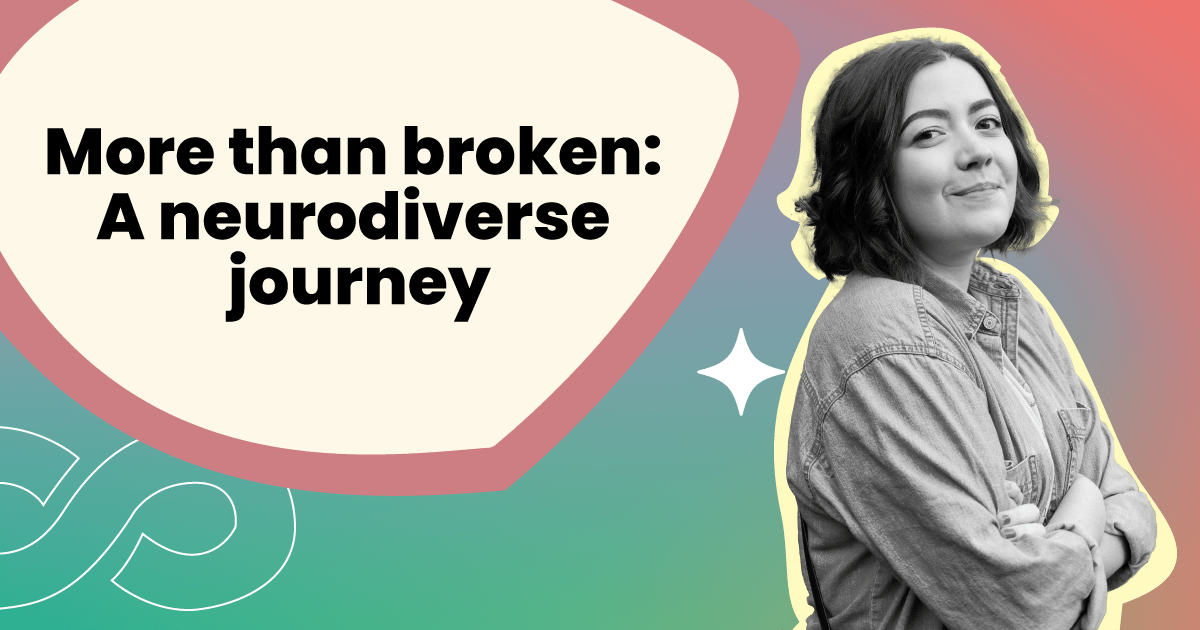OpenSesame celebrates the diversity of all of our employees and fosters community through our Employee Resource Groups. Hear from Neurodiversity ERG Leader and eLearning Development Associate, Missy LeDoux, as she shares her story of accepting neurodiversity as a superpower.
Part I: Thinking I Was Broken
“Are you Emily’s little sister?” If you grew up attending the same school as your older sibling, you’ve probably been asked similar questions by teachers. My sibling and I got along well, but I always felt a level of competition. If Emily got straight A’s, I needed to as well. In the shadow of an intelligent sibling, I became a high-achieving student too. I loved learning, loved reading, and found school genuinely interesting. I signed up for nearly every advanced and AP class, and as my sibling headed off to an Ivy League college, I thought I just might follow in their footsteps.
But something else was happening at the same time. My brain was breaking – at least, that’s what it felt like. School was getting harder. Procrastination went from an occasional bad habit to my only way of functioning. In high school, I was experiencing crippling anxiety attacks and pervasive bouts of depression.
The problem with my brain felt like a slow paralysis. I would tell myself it was time to study, but the mental processes that used to involuntarily click into gear – feet carrying me over to my desk, hand reaching for a pencil – became less and less responsive. Eventually, I’d have to trick myself. One Sour Patch Kid per page of the textbook. Study for five minutes, and then you can have a YouTube break. Pretend there’s a timer counting down, and if you don’t unload the dishwasher before time runs out, a bomb will go off.
Sometimes the tricks weren’t enough. The only trick that never failed was urgency. Headlights flashing through the front window meant my parents were home. I quickly learned exactly how fast I could work when properly motivated. Did you know that a dishwasher can be loaded in under 40 seconds flat? Just ask an anxious neurodiverse high-achiever.
If you or a loved one has ADHD, you’ve probably figured out by this point that that’s what I have. The tricks I’m describing are actually pretty standard ways of overcoming a phenomenon known informally as “ADHD paralysis.” Unfortunately, I wouldn’t figure it out for years. Doctors and counselors only noticed my anxiety and depression. It’s hard to blame them – for years, ADHD was thought of as a problem for boys more than girls. Hyperactivity is the easiest symptom to spot, and I was a quiet, anxious, polite kid. All I knew was that the competent image I presented to the world was starkly different from the unknowable chaos swirling inside of me.
Part II: Thinking I Was Superhuman
In college, my issues with focus and motivation worsened and my mental health challenges continued. But another dimension of my neurodiversity began to take shape.
Her name was ÜberMissy.
Yeah – I named her. That’s because she didn’t feel like the same person as me. She was this distinct, separate entity. I couldn’t call her at will; she came when she wanted to. Like a superhero changing in a phone booth, she would swoop in at the last minute and save the day. ÜberMissy could write papers at lightning speeds, memorize flashcards for a test, and complete a week’s worth of classwork in one night. She didn’t need sleep or food. She was fueled by unsweetened black tea and the delicious certainty of a concrete deadline. She carried me through years of procrastination, academic imposter syndrome, and an all-or-nothing work ethic.
We all have systems we use to be productive, but some systems are better than others. My system involved constant anxiety, never getting enough sleep, and always worrying that someone would uncover the mental chaos behind my polished exterior. It required constant “masking” – a term used by the neurodiversity community to mean “pretending to be neurotypical.”
Part III – Community and Complexity
In 2020, I returned to therapy, hoping to figure out a better system. Instead, I got an ADHD diagnosis. Around the same time, a neurodiversity group began to form at OpenSesame. Not only did I suddenly have a name for my half-broken-half-superhuman brain, I now had a community of people with similar challenges. Joining the Neurodiversity ERG at OpenSesame while researching my own diagnosis meant I had an influx of new strategies to try out. But most importantly, it meant I could finally start the process of setting down the shame associated with hiding. Talking about my struggles in a space where people understood them made it easier for me to accept them.
I began to embrace the value of the word “and” in conversations about ADHD and neurodiversity. It’s not strictly a good thing or a bad thing. It’s a disorder and a strength. A disability and a valuable asset. The thing I experienced as being broken is known as executive dysfunction. It does mean that something in my brain doesn’t work in the typical way, and it requires a lot of work and creativity to complete tasks that might be incredibly easy for an average person. The part I experienced as a superpower is known as hyperfocus, and it really can be a secret weapon – but learning how to harness it correctly is going to take a long time.
Being neurodiverse has taught me that things aren’t as black-and-white as I once thought. And these valuable complexities are part of the diversity any team needs to be successful.
